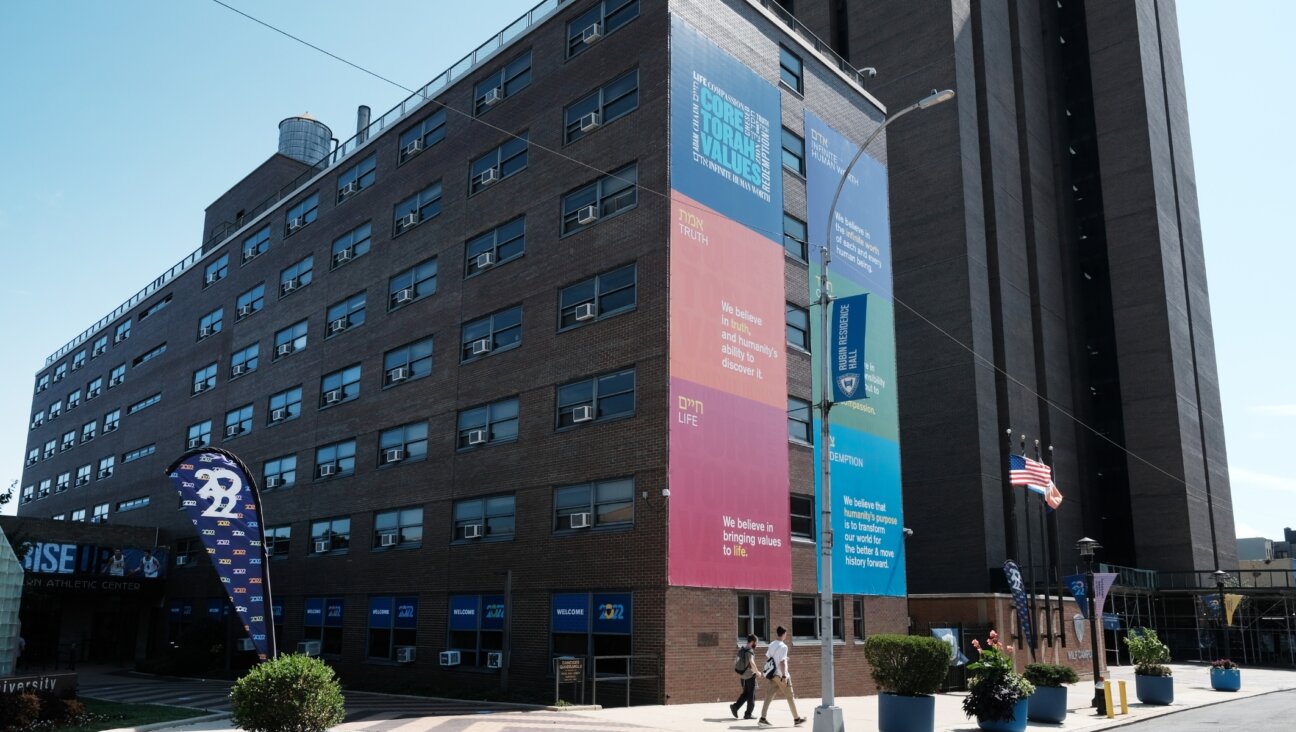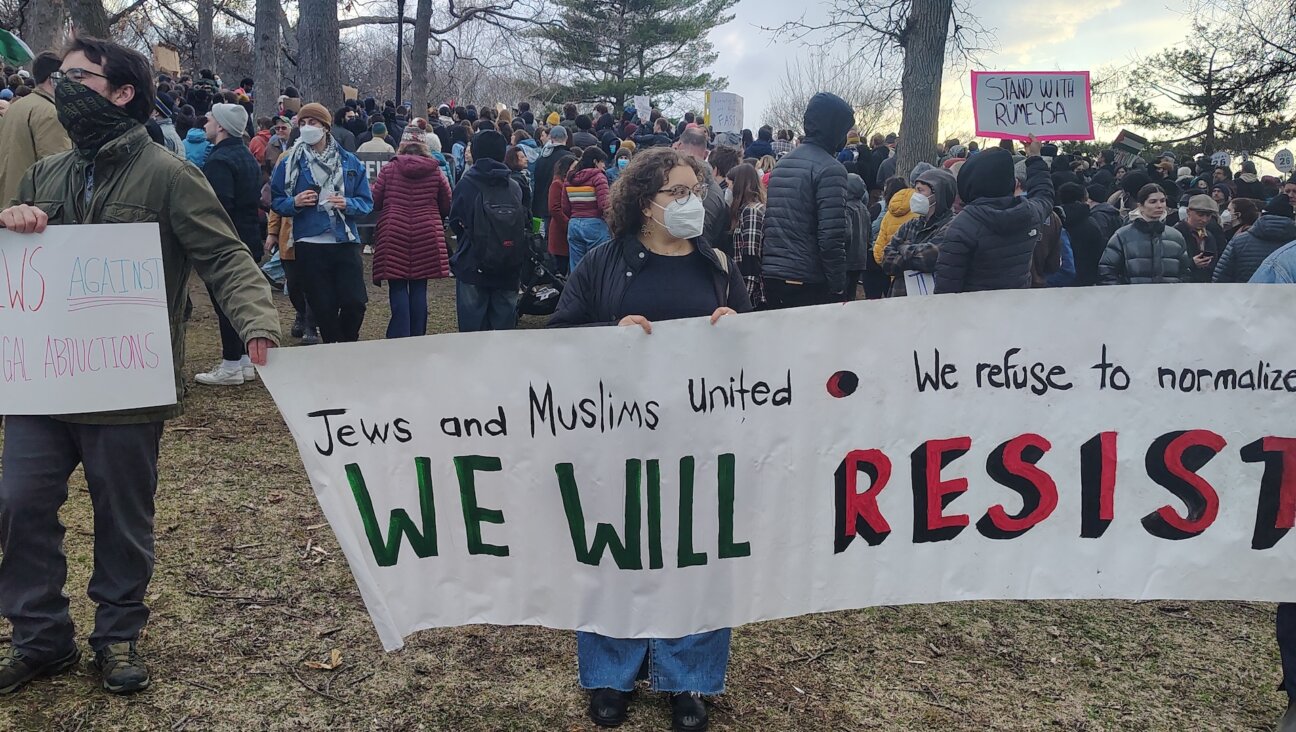Jews of Color Gather To Explore, Celebrate Identity
Dafna Wu, a 48-year-old San Francisco nurse, resembles her Chinese father more than her Jewish mother. She’s been Jewish her whole life, but she’s used to walking into synagogues and having people ask who she’s with, as if she didn’t belong there of her own accord.
Her oldest daughter, Ruby, 24, looks like the Jewish man who fathered her, “like someone from a Vishniac photo,” Wu says.
When Ruby was a baby, Wu says, “people thought I was her nanny.”
But Wu’s youngest child, 9-year-old Amalia, has a Chinese father and looks Asian. The Hebrew school she attends is filled with mixed-race children, but the parents in the congregation are all white. Amalia is in the minority, which concerns her mother.
“All my life I’ve had to defend being Jewish,” Wu says. “I don’t want her to have to explain her Judaism or be exoticized for it. I just want her to be a kid, not ‘that special, multi-racial kid.’ ”
That’s why Wu brings Amalia to Be’chol Lashon’s retreats and holiday celebrations.
At Be’chol Lashon, a San Francisco-based organization for ethnically and racially diverse Jews and their families, Amalia plays with other Jewish children who are black, Hispanic and Asian, as well as a sprinkling of white children from non-conventional families. They study Hebrew, celebrate the holidays, read Bible stories and learn about Israel, but they also talk openly with their counselors about what it means to be Jews of color, to juggle an identity people can’t see with the one proclaimed by their skin.
About 5.4 percent of America’s Jews are non-white or Hispanic, according to the 2000-2001 National Jewish Population Survey. A 2004 study by the Institute for Jewish and Community Research, Be’chol Lashon’s parent organization, puts the figure at about 10 percent.
Nevertheless, say activists in the field, the prevailing assumption is that Jews in the United States are white, and that Jews of other racial or ethnic backgrounds are adoptees or converts. Sometimes they are, but increasingly they are not, as the children of mixed-race couples grow to adulthood and begin raising their own Jewish children.
As their numbers grow, mixed-race Jewish families are facing the same question often put to interfaith families: Is there a need for separate programming?
The answer, judging by the growth in the field, seems to be yes.
After 12 years of holiday programming in San Francisco and six years of annual fall retreats, Be’chol Lashon ran its first summer camp in June, when a critical mass of its families’ children reached the 8-to-12 age group. An East Coast organization with similar goals, the Jewish Multiracial Network, founded by white Ashkenazi parents of African-American children, this summer formally passed leadership on to the next generation and is now run by and for Jews of color.
Both organizations have greatly expanded their activities this year. Be’chol Lashon, which used to limit programming to the San Francisco Bay Area, now has representatives in Los Angeles, New York and Chicago, as well as a rabbi in Oklahoma City who works with anusim, Hispanics of Jewish ancestry. And the Jewish Multiracial Network, which sponsors an annual retreat and an active listserve, since September has held potluck gatherings and town hall meetings in Boston, New York and Philadelphia, and is planning one for Los Angeles.
“This is a population that is growing, that deserves our sensitivity, and is not getting it,” says Paul Golin, associate director of the Jewish Outreach Institute.
Golin has participated in Jewish Multiracial Network events. His wife is Japanese, and he expects their future children to face the same questions she experiences in Jewish settings.
“I’ve learned a tremendous amount of what it means to have white privilege,” he says. “I was fairly oblivious to it before. There’s white privilege in America, and Ashkenazi privilege in the Jewish world.”
But Be’chol Lashon founder and director Diane Tobin says she notices a “marked increase of interest” in reaching out to non-white Jews within the greater Jewish community.
“Diversity has become a very popular issue, especially with the election of Barack Obama,” she says.
At the most recent Be’chol Lashon fall retreat, held Oct. 2-4 at Walker Creek Ranch just north of San Francisco, parents interviewed said they don’t want to segregate their children from the larger community. Most, but not all, send their children to mainstream religious schools and belong to synagogues. They look at the Be’chol Lashon activities as supplementary, giving them space to explore their connection to Judaism without having to explain who they are.
Tobin created Be’chol Lashon with her husband, the late Gary Tobin, 12 years ago when they adopted Jonah, who is African American. The Tobins’ daughter, Sarah Spencer, who was 21 at the time, was in on the decision.
“We thought it was important to have a community where Jonah and kids like him would not have to choose between their identities, where they didn’t have to be black sometimes and Jewish sometimes,” Spencer says.
Spencer, who has a 2-year-old son with her husband, a black Jamaican, says at first she wasn’t sure there was a need for the new summer camp.
“But every parent I’ve talked to in the program says they’ve been looking for this,” she says. “So it seems there was a void.”
And it’s not just the parents. Children who attended the camp this summer say they feel the difference.
“I have more friends that understand me here,” says 10-year-old Aviva Davis, whose mother is the camp director.
At both Jewish Multiracial Network and Be’chol Lashon, mixed-race or non-white children who grew up in the organizations are taking over from their parents’ generation.
The biggest upheaval took place within the Jewish Multiracial Network in June when Tanya Bowers, 36, of Washington was elected the group’s first African-American president.
“The shift is happening now,” she says.
The group was started by Ashkenazim who adopted multi-racially, and for the past several years Bowers says there has been “some tension between these well-intentioned Jewish parents and the people of color in the organization, a lot of control issues.” By this summer the parents were ready to let go, and Bower stepped forward.
“We still want the parents involved,” she says. But the agenda is being set by the new generation. The summer retreat was the first to boast a separate track for Jews of color, along with the previous tracks set up by the group’s founders.
Within Be’chol Lashon, young non-white faces are more prevalent in the group’s leadership.
Kenny Kahn, 27, the son of a white Jewish mother and black non-Jewish father, is a veteran of Hebrew school, Jewish summer camps and an Israel program, and has been coming to Be’chol Lashon for 12 years. He now serves as head counselor at the retreats and summer camp.
Kahn grew up in Richmond, a heavily African-American city north of Berkeley, and attended Temple Beth El, a Reform congregation in Berkeley.
“I had my Richmond friends and my Beth El friends,” he says. “Being able to mediate between those two worlds has become a theme in my life.”
A big, friendly guy who looks more African American than white, Kahn says he never experienced anti-Semitism in the black community or raised eyebrows in the Jewish community. But he relishes the space Be’chol Lashon provides him and his peers to explore their Judaism at leisure with others who share their backgrounds and concerns.
“In California we’re blessed with tolerance,” he says. “But tolerance is just the first step to acceptance, and that’s what we need more of in the Jewish community.”
The Forward is free to read, but it isn’t free to produce

I hope you appreciated this article. Before you go, I’d like to ask you to please support the Forward.
Now more than ever, American Jews need independent news they can trust, with reporting driven by truth, not ideology. We serve you, not any ideological agenda.
At a time when other newsrooms are closing or cutting back, the Forward has removed its paywall and invested additional resources to report on the ground from Israel and around the U.S. on the impact of the war, rising antisemitism and polarized discourse.
This is a great time to support independent Jewish journalism you rely on. Make a gift today!
— Rachel Fishman Feddersen, Publisher and CEO
Support our mission to tell the Jewish story fully and fairly.
Most Popular
- 1

Fast Forward Ye debuts ‘Heil Hitler’ music video that includes a sample of a Hitler speech
- 2

Opinion It looks like Israel totally underestimated Trump
- 3

Culture Cardinals are Catholic, not Jewish — so why do they all wear yarmulkes?
- 4

Fast Forward Student suspended for ‘F— the Jews’ video defends himself on antisemitic podcast
In Case You Missed It
-

Culture How one Jewish woman fought the Nazis — and helped found a new Italian republic
-

Opinion It looks like Israel totally underestimated Trump
-

Fast Forward Betar ‘almost exclusively triggered’ former student’s detention, judge says
-

Fast Forward ‘Honey, he’s had enough of you’: Trump’s Middle East moves increasingly appear to sideline Israel
-
Shop the Forward Store
100% of profits support our journalism
Republish This Story
Please read before republishing
We’re happy to make this story available to republish for free, unless it originated with JTA, Haaretz or another publication (as indicated on the article) and as long as you follow our guidelines.
You must comply with the following:
- Credit the Forward
- Retain our pixel
- Preserve our canonical link in Google search
- Add a noindex tag in Google search
See our full guidelines for more information, and this guide for detail about canonical URLs.
To republish, copy the HTML by clicking on the yellow button to the right; it includes our tracking pixel, all paragraph styles and hyperlinks, the author byline and credit to the Forward. It does not include images; to avoid copyright violations, you must add them manually, following our guidelines. Please email us at [email protected], subject line “republish,” with any questions or to let us know what stories you’re picking up.













